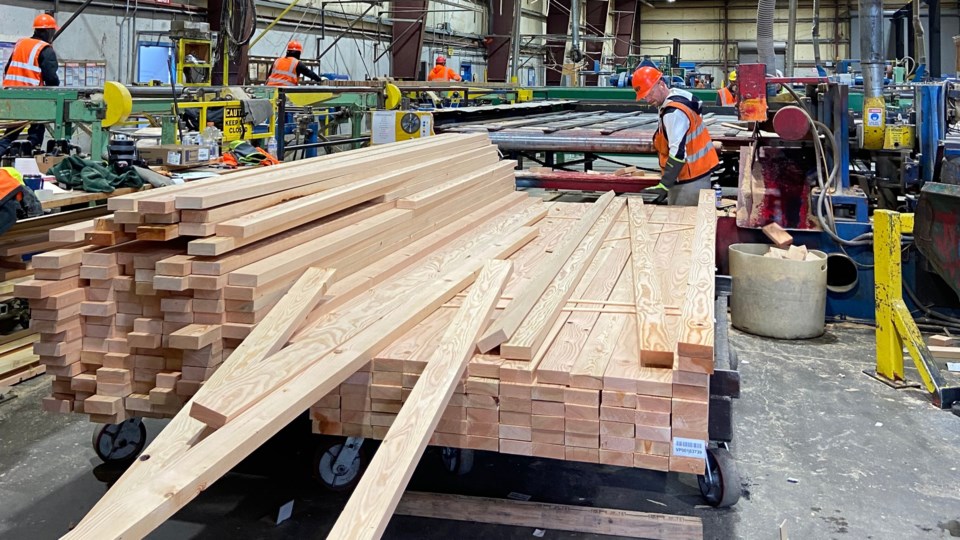The B.C. government has been doing a good job of creating domestic demand for engineered wood products, as evidenced by the more than 350 construction projects in B.C. that use or propose using mass timber, according to a Natural Resources Canada database.
The question is: Can B.C. forests deliver on the supply?
And critically, can the provincial government create the conditions needed to encourage forestry companies in B.C. to invest hundreds of millions of dollars in higher value-added engineered wood product manufacturing? Or, will the province instead lose market share to American and European manufacturers?
“The government’s pushing really hard on this right now because, at the moment, this is B.C.’s bet to lose,” said Nicholas Sills, a former general manager of customer and technical services for Structurlam who now runs Whirlwind Consulting. “We are definitely leaders in technical expertise, and we have many of the resources, although our forests are pushed to a utilization limit.”
Whether it was making structural lumber or pulp and paper, B.C. has long had one advantage: Plenty of raw input material in the form of lots of timber. It no longer has that advantage.
And whether you are making two-by-fours, or the lamstock used to make the glulam that is in turn used to make beams, columns and girders in mass-timber construction, you need trees to make it. Though B.C. hasn’t run out of trees, exactly, it does appear to have run out of economically harvestable timber.
“There is no generic shortage of trees in B.C.,” notes a recent report commissioned by three unions representing B.C. sawmill and pulp mill workers.
“Indeed, recent harvesting volumes have fallen substantially below the annual allowable cut … because of general uncertainty and uneconomic conditions in accessing that fibre supply,” says the report, A Better Future for B.C. Forestry.
“What is lacking is an integrated, holistic, and consistent management plan to ensure that sufficient fibre is provided to sustain downstream forest industries. That commitment to stable fibre supply must then be paired with a strong strategy to maximize value-added opportunities arising from that resource supply.”
The report points to a major decline in B.C.’s forestry sector over the past two decades—from 79,000 workers in 2001 to 44,000 today, with 9000 jobs lost just in the last five years—as sawmills and pulp mills continue to shutter, due to high operating costs and shrinking timber supply. The report urges policy changes to at least arrest the decline.
Meanwhile, provincial and municipal governments have been adopting policies and incentives to encourage more use of mass timber in construction. Not only are there climate benefits (since wood has a lower emissions profile than steel and concrete), there is also hope that creating domestic demand for mass timber will spur investments in higher value-added engineered wood manufacturing, like glulam (used to make mass-timber beams and girders) and cross-laminated timber (CLT), used to make the large panels used for flooring, ceilings and walls.
There are now half a dozen companies in B.C. that make some form of engineered wood products, like CLT, glulam and dowel-laminated timber (DLT). But this kind secondary manufacturing still depends on a healthy primary manufacturing sector, which depends on a reliable timber supply. Growing this form of manufacturing necessarily means addressing a fundamental timber supply problem.
“In my opinion, we’re exporting a lot of material at lower value right now,” said Sills. “So that includes pellets, commodity lumber, two-by-fours, logs. And there’s a lot more value we could certainly add here, and there’s huge demand, not only within British Columbia, but within North America.”
Western Forest Products (TSX:WEF) is one legacy forestry company in B.C. that has been moving into engineered wood products. Last year the company bought Washington state glulam maker Calvert Co.
Western also recently invested $12 million on a new drying kiln at its Saltair sawmill in Ladysmith and plans to spend $35 million adding new drying kilns at its Duke Point sawmill in Nanaimo and its Chemainus remanufacturing plant. Wood that goes into products like glulam require lower moisture content, which requires more kiln drying.
But the bottom line is that B.C. manufacturers will have competition, so if the government is seriously about fostering a mass timber manufacturing sector, it needs to ensure there is a competitive investment and operating environment.
“When you’re in a commodity application, and you’re a high-cost jurisdiction, you need to get a point where the whole business—from harvesting, through to lumber manufacturing, to remanufacturing, to engineered wood—have the appropriate hosting conditions and cost profiles that allows us to be competitive,” said Stephen Williams, CFO for Western Forest Products.
“Because today, there’s panels that come from Europe all the way to the West Coast of British Columbia more cost effectively than we can produce it. We have the timber, but you have to be able to economically produce the product.”
Mina Laudan, vice-president of corporate affairs for Canfor Corp. (TSX:CFP), agrees. Canfor makes lamstock (used to make glulam), but has not yet moved into making engineered wood products itself.
“We have the know-how and the expertise here in B.C.,” she said. “There are obstacles. It isn’t a shortage of merchantable timber. The timber harvest is there—it’s how we can’t access it. We’re not able to fully access it.
“Without that healthy primary production, that is going to be an obstacle to really growing a value-added manufacturing centre of expertise in this province.”




